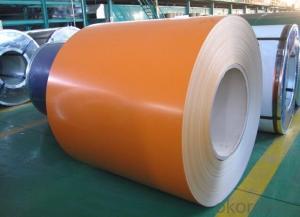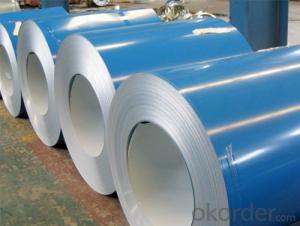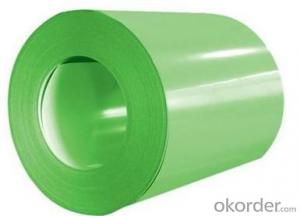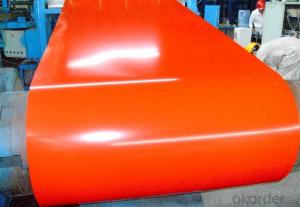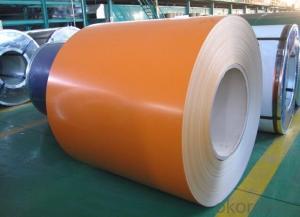Pre-painted Galvanized/Aluzinc Steel Sheet Coil with P r ime Quality and Lowest Price Orange
- Loading Port:
- Shanghai
- Payment Terms:
- TT OR LC
- Min Order Qty:
- 100 m.t.
- Supply Capability:
- 10000 m.t./month
OKorder Service Pledge
OKorder Financial Service
You Might Also Like
1.Structure of Pre-painted Galvanized/Aluzinc Steel Coil Description
With GI (aluzinc) as base metal, after pretreatment (degrease and chemical treatment) and liquid dope with several layers of color, then after firing and cooling
2.Main Features of the Pre-painted Galvanized/Aluzinc Steel Coil
• Excellent heat resistance performance
• High strength
• Good formability
• Good visual effect
3.Pre-painted Galvanized/Aluzinc Steel Coil Images
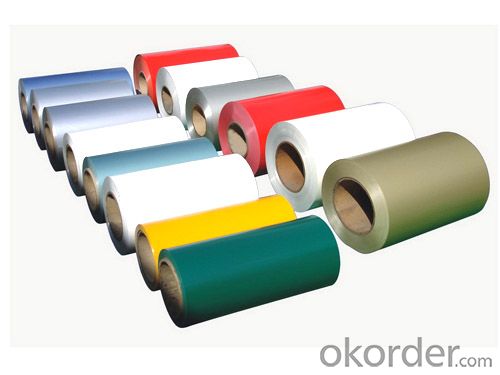
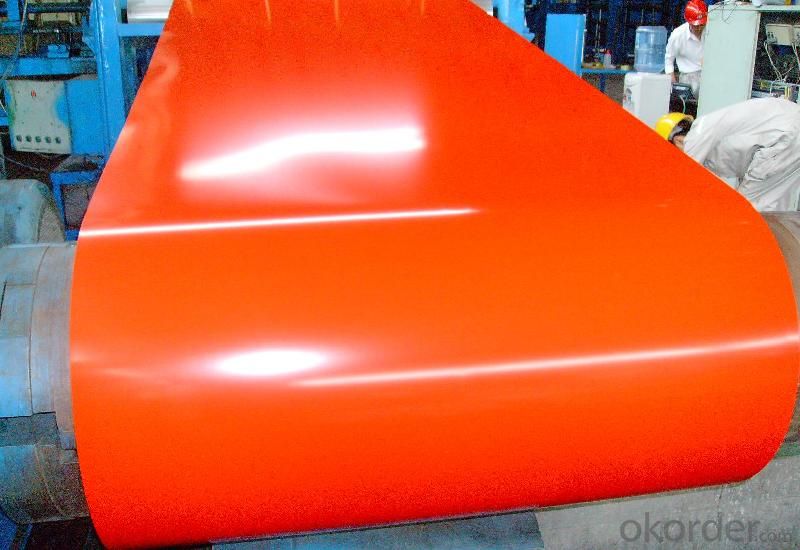
4.Pre-painted Galvanized/Aluzinc Steel Coil Specification
Surface finish: with or without protect film
Quality standar: JIS G3312 CGCC & CGLCC
Hardness of P: Both soft and hard quality are available
Thickness : 0.14-1.20 mm
Paint thickness for top side : 5 micron primer + (10-20) microns modified polyester, any RAL color code.
Paint thickness for back side: (5-10) microns Epoxy
Width : 914mm, 1000mm, 1220mm and 1250mm, thickness 600-1250mm is available
Finish by coil or sheet: Both sheet and coil are available
8Zinc coating: 60-275G/M2, both sides
Weight per coil: 4-6 tons, also can be upon customer's requirements
Max loading weight in one 20ft container : 25 tons generally
5. FAQ of Pre-painted Galvanized/Aluzinc Steel Coil
We have organized several common questions for our clients,may help you sincerely:
1. What is the minimum order quantity ?
Our MOQ is 50mt for each size. And we will consider to give more discount if you make big order like 1000 tons and more.
- Q: What are the different finishes available for steel coils?
- There are several different finishes available for steel coils, each offering its own unique set of characteristics and benefits. Some of the most common finishes include: 1. Hot-dip galvanized: This finish involves immersing the steel coil in a bath of molten zinc, which creates a protective layer that prevents corrosion and rust. It provides excellent durability and long-term protection against harsh environmental conditions. 2. Electro-galvanized: Similar to hot-dip galvanizing, this finish uses an electrical current to apply a thin layer of zinc onto the steel coil. It offers good corrosion resistance and aesthetics, making it suitable for various applications. 3. Galvannealed: This finish combines the benefits of galvanizing and annealing processes. The steel coil is first galvanized and then annealed, resulting in a matte grey appearance with enhanced paint adhesion. Galvannealed finishes are commonly used in automotive and appliance industries. 4. Pre-painted: Also known as coil coating, this finish involves applying a layer of paint onto the steel coil before it is formed into its final product. Pre-painted finishes offer a wide range of colors, textures, and gloss levels, allowing for customization and improved aesthetics. 5. Stainless steel: Steel coils can also be finished with a layer of stainless steel, which provides excellent resistance to corrosion, heat, and chemicals. Stainless steel finishes are often utilized in applications where hygiene, durability, and a high-quality appearance are essential, such as in the food and beverage industry. 6. Cold-rolled: This finish involves passing the steel coil through a series of rollers at room temperature, resulting in a smooth, polished surface. Cold-rolled finishes offer improved dimensional accuracy, surface quality, and flatness, making them suitable for applications that require tight tolerances and a refined appearance. 7. Metallic coated: This finish involves applying a layer of a metallic coating, such as aluminum or zinc-aluminum alloy, onto the steel coil. Metallic coated finishes offer excellent corrosion resistance, lightweight properties, and aesthetic versatility. Overall, the choice of finish for steel coils depends on the specific requirements of the application, considering factors such as corrosion resistance, aesthetics, durability, and cost-effectiveness. It is important to consult with industry experts and manufacturers to determine the most suitable finish for a particular project.
- Q: How are steel coils used in the production of metal containers?
- Steel coils are widely used in the production of metal containers due to their versatility and strength. The process of manufacturing metal containers typically involves several steps, and steel coils play a crucial role in each of these stages. Firstly, steel coils are used as the primary raw material in the production of metal containers. The coils are made of high-quality steel that is rolled into a continuous sheet, ensuring consistent thickness and durability. This sheet is then cut into specific widths and lengths according to the size requirements of the containers. Once the steel coils are cut into the desired dimensions, they are formed into the shape of the container using various techniques. One common method is called roll forming, where the steel coil is passed through a series of roll dies that progressively shape it into the desired container shape. This can be done to create containers of various sizes and designs, such as cans, drums, or even large industrial containers. After the initial forming process, the steel coils are further processed to enhance their strength and durability. This can involve heat treatment, where the coils are exposed to high temperatures to increase their hardness and resistance to wear and tear. Other processes like annealing and quenching may also be utilized to improve the steel's properties. Once the containers are formed and processed, they undergo additional fabrication steps such as welding or sealing to ensure their structural integrity. Steel coils are often used in these processes as well, as they provide a strong and reliable material to create sturdy seams and joints. Finally, the metal containers are finished by applying various coatings or treatments to protect them from rust, corrosion, or other environmental factors. Steel coils can be coated with materials such as paint, epoxy, or zinc to enhance their resistance to these elements, ensuring the longevity of the containers. In summary, steel coils are essential components in the production of metal containers. From being the primary raw material to being used in forming, processing, and finishing, steel coils provide the strength, durability, and versatility necessary for the manufacturing of reliable metal containers for various industries.
- Q: How are steel coils inspected for paint adhesion using adhesion testers?
- Steel coils are inspected for paint adhesion using adhesion testers by applying a controlled amount of force to a specially prepared test area on the coil's surface. The adhesion tester measures the amount of force required to remove the paint coating from the surface, providing a quantitative assessment of the paint adhesion. This process helps ensure the quality and durability of the paint coating on the steel coils.
- Q: What are the common defects found in steel coils?
- Some common defects found in steel coils include surface defects such as scratches, dents, and rust spots. Other defects may include coil breaks, which are cracks or breaks in the steel, as well as wavy edges, uneven thickness, and coil set, which is when the coil has a permanent curvature.
- Q: What are the factors influencing the price of steel coils?
- The price of steel coils can be influenced by a variety of factors. These factors include: 1. Raw material costs: The cost of raw materials, such as iron ore and coal, directly affects the price of steel coils. Fluctuations in commodity prices can have a significant impact on the overall price. 2. Supply and demand: The balance between supply and demand in the steel industry plays a crucial role in determining the price of steel coils. If there is high demand, prices are likely to increase. Conversely, if there is an oversupply, prices may decrease. 3. Production and manufacturing costs: The cost of producing and manufacturing steel coils, including labor, energy, and transportation costs, can also impact the final price. Any changes in these costs can influence the overall price. 4. Currency exchange rates: The price of steel coils can be affected by fluctuations in currency exchange rates. If the currency in which steel is traded weakens against other currencies, it can result in higher prices. 5. Government regulations and policies: Government regulations, such as import tariffs, export restrictions, and environmental regulations, can impact the price of steel coils. These regulations can affect the cost of production and trade, ultimately influencing the price. 6. Market competition: The level of competition among steel manufacturers and suppliers can also impact the price of steel coils. If there are many suppliers and manufacturers, it can lead to competitive pricing and potentially lower prices. Conversely, if there are few suppliers dominating the market, prices may be higher. It is important to consider that these factors can vary over time and in different regions, which ultimately affects the pricing of steel coils in the market.
- Q: How are steel coils inspected for quality?
- Steel coils are inspected for quality through various methods such as visual inspection, dimensional checks, and non-destructive testing techniques. This ensures that the coils meet specific criteria including surface finish, dimensions, and structural integrity.
- Q: Can steel coils be bent or formed into different shapes?
- Yes, steel coils can be bent or formed into different shapes. Steel coils are typically made from flat rolled steel, which is flexible and can be easily manipulated. The bending process involves applying force to the steel coil, causing it to change shape and form into various configurations. This can be achieved through different techniques such as cold bending, hot bending, or using specialized machinery like a press brake. By applying the appropriate amount of force and heat, steel coils can be bent or formed into a wide range of shapes, including curves, angles, and complex geometries. This versatility in shaping steel coils makes them highly adaptable for various applications, such as in construction, manufacturing, automotive, and many other industries.
- Q: How are steel coils shaped into specific forms?
- Steel coils are shaped into specific forms through a process called cold forming or cold rolling. This involves passing the steel coil through a series of rollers that gradually shape and form it into the desired shape, such as sheets, strips, or tubes. The precise dimensions and specifications of the final form are achieved by adjusting the pressure and alignment of the rollers.
- Q: How do steel coils affect the quality of finished products?
- Steel coils can have a significant impact on the quality of finished products. Their quality, including dimensions, surface condition, and mechanical properties, directly affects the final product's strength, durability, and appearance. Coils with inconsistent dimensions or surface defects can lead to uneven or weak finished products. Similarly, if the mechanical properties of the coils do not meet the required specifications, it can compromise the performance and functionality of the end product. Therefore, ensuring the high quality of steel coils is crucial for achieving superior finished product quality.
- Q: How are steel coils inspected for uniformity?
- Steel coils are inspected for uniformity through visual examination and various non-destructive testing techniques. These include measuring the dimensions and weight of the coils, checking for any surface defects or damages, and conducting magnetic particle or ultrasonic testing to detect any internal flaws or irregularities. Additionally, the coils may undergo chemical composition analysis to ensure uniformity in the steel's properties.
Send your message to us
Pre-painted Galvanized/Aluzinc Steel Sheet Coil with P r ime Quality and Lowest Price Orange
- Loading Port:
- Shanghai
- Payment Terms:
- TT OR LC
- Min Order Qty:
- 100 m.t.
- Supply Capability:
- 10000 m.t./month
OKorder Service Pledge
OKorder Financial Service
Similar products
Hot products
Hot Searches
Related keywords
